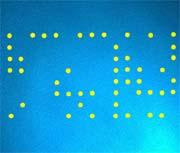You may want to think twice about printing this article. Many colour laser printers mark the pages they produce with tiny yellow dots that, according to technology watchdogs, can reveal information about you and your computer.
The Electronic Frontier Foundation (EFF), based in San Francisco, California, announced this week that it had cracked the code of dots on documents made by Xerox DocuColor printers.
"We've discovered exactly what information is there and how you can read it," explains EFF technologist Seth Schoen.
 A grid of yellow dots, best seen under blue light, reveals the time and date that a document was printed.© Electronic Frontier Foundation
A grid of yellow dots, best seen under blue light, reveals the time and date that a document was printed.© Electronic Frontier FoundationOther people had noticed the yellow dots, but Schoen says the meaning of the markings had been unclear. So EFF researchers collected pages from various copy centres in California this summer and analysed them, using blue light to highlight the dots, which are barely visible under normal light. It took just a week to crack the code.
EFF and its partners report that the dots contains information about the date and time that a page was made, as well as the serial number of the printer used. These are encoded in a simple grid, in which the eight rows represent different values that are added up to reveal 5 kinds of information held in 15 columns. The final column, which is often blank, codes for something that is still a mystery to EFF researchers.
“We've discovered exactly what information is there and how you can read it.”
Seth Schoen
Electronic Frontier Foundation, San Francisco, California
They think the information is probably used in police inquiries about counterfeiting and to track down the source of printed documents in crime cases. Their findings are published in a Dot Decoding Guide on the EFF website.
Colour coded
But which part of the machine generates these dots? "It's definitely the hardware. The dots show up regardless of what operating system and what kind of document you have," says Schoen.
Bill McKee, a spokesman for Xerox, which is based in Stamford, Connecticut, told news@nature.com that he "can confirm there is a coding system" on pages printed by DocuColor machines. But he says that "because of security we cannot disclose any details". He adds that Xerox does not routinely hand out customer information but "will assist an investigating agency when asked".
EFF submitted a request this summer using the Freedom of Information Act to find out whether the US Secret Service has used the dots to track down the source of documents.
"We're not happy that this code is there," says Schoen. A covert code of dots raises grave privacy concerns, he claims. "We first and foremost want to let people know what their printers are doing."
ADVERTISEMENT
EFF has also collected pages from volunteers in countries ranging from Australia to Israel in order to catalogue the printers from a variety of manufacturers that mark pages. The group states that many of the printers from other companies also seem to produce pages with anomalous dots.
Schoen notes that the absence of dots does not necessarily prove that there's no tracking technology. But he hopes that they will find a machine that does not mark the pages it prints: "If there is a printer that doesn't do this we'd like to see that product derive a competitive advantage in the market."
Electronic Frontier Foundation, San Francisco, California
